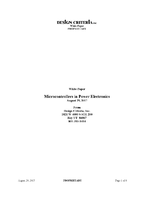Northrop Grumman Completes 12th Successful Flight Test of Enhanced Wideband Networking Capability
Share:
SAN DIEGO, Aug. 22, 2006 -- Northrop Grumman Corporation (NYSE:NOC) recently completed the 12th in a series of ongoing flight tests of an enhanced Wideband Networking Waveform (WNW). The enhanced WNW software, hosted on Northrop Grumman-developed software-defined radios, successfully demonstrated key airborne network waveform capabilities.
WNW is designed to facilitate interoperability between the services; provide seamless delivery of video, voice and data; and support ad hoc formation of scalable networks. The U.S. Department of Defense has specified WNW for the Joint Tactical Radio System (JTRS) program to establish Internet Protocol-based networking and provide transformational communications for the warfighter.
Northrop Grumman made enhancements to the WNW Orthogonal Frequency-Division Multiplexing (OFDM) signal to address performance risks encountered in "fast mover" aerodynamic flight environments such as Doppler frequency shifts and multipath interference. Improvements were also implemented for rapid net entry and extended range.
Northrop Grumman successfully conducted WNW OFDM communications in a high differential Doppler, multipath environment with ranges exceeding 100 nautical miles. The flight-test scenarios demonstrated the ability to join and leave the network on an impromptu basis with application data that included streaming video, high-resolution still imagery, text messaging and chat. All software was running in a JTRS Software Communications Architecture-compliant environment. The waveform enhancements were developed in collaboration with Nova Engineering of Cincinnati, Ohio.
In addition, Northrop Grumman successfully ported and demonstrated Soldier Radio Waveform and Tactical Common Data Link communication capabilities on the same software-defined JTRS radios.
"A key feature of our airborne implementation is the ability to host the modified waveform on standard universal transceivers and security architectures that are widely used on JTRS programs today," said Greg Jones, director of JTRS Projects for Radio Systems, Northrop Grumman Space Technology. "We believe this can significantly lower the government's cost of fielding an airborne networking waveform."
Northrop Grumman Space Technology develops and produces the software-defined radios that perform numerous critical communications, navigation and identification functions for the F-22 Raptor and the F-35 Lightning II. Northrop Grumman is leveraging the successes of these advanced fighter avionics programs to provide innovative technology solutions for the government's JTRS enterprise.
JTRS has the objective to develop and field a family of interoperable, software-defined radios that operate as nodes in a network to ensure secure wireless communications and networking services for mobile and fixed forces. JTRS is central to implementing the Defense Department's vision of network-centric operations and information superiority.
Nova Engineering is an employee-owned company specializing in the design and development of leading-edge digital communications and signal-processing systems. Since 1989, Nova Engineering has successfully deployed systems for a variety of customers, including all branches of the U.S. military and many government agencies.
Northrop Grumman Corporation is a global defense company headquartered in Los Angeles, Calif. Northrop Grumman provides technologically advanced, innovative products, services and solutions in systems integration, defense electronics, information technology, advanced aircraft, shipbuilding and space technology. With more than 120,000 employees and operations in all 50 states and 25 countries, Northrop Grumman serves U.S. and international military, government and commercial customers.
CONTACT:
Sudi Bruni
Northrop Grumman Space Technology
(858) 592-3407
sudi.bruni@ngc.com




